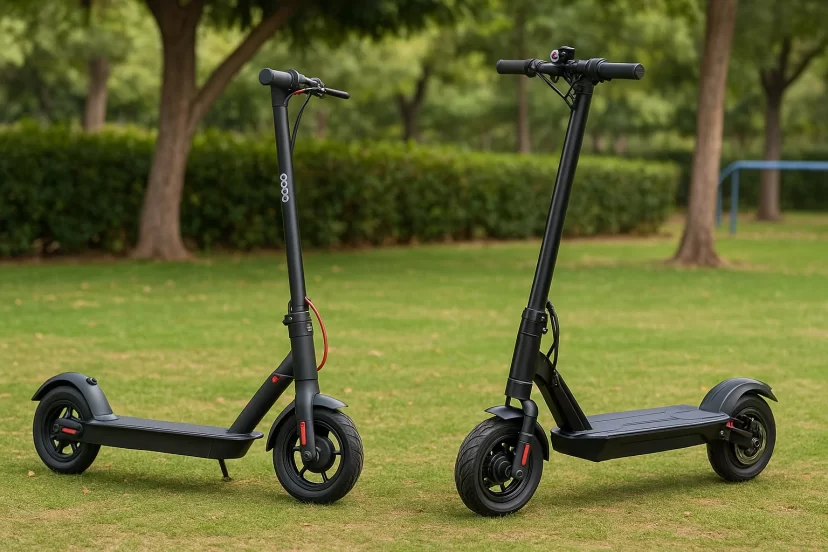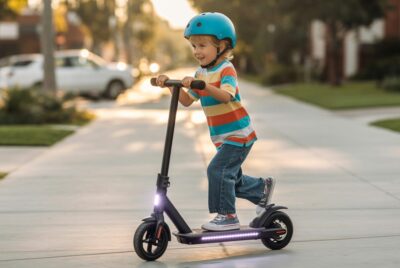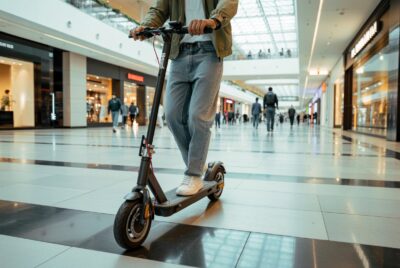Apollo vs. Kaabo: Best Electric Scooter Brand in 2025
*We may earn a commission for purchases made using our links. Please see our disclosure to learn more.
The electric scooter revolution has fundamentally transformed urban transportation, evolving from a novelty item into an essential mobility solution for millions worldwide. As cities grapple with congestion and environmental concerns, personal electric vehicles have emerged as a practical answer to the last-mile problem. Among the dozens of manufacturers competing for market dominance, two brands have consistently risen above the rest: Apollo and Kaabo.
Apollo, the Canadian innovator, has built its reputation on creating sophisticated urban mobility solutions that blend style with substance. Their scooters embody the modern commuter’s needs, portable, reliable, and aesthetically pleasing without sacrificing performance. Kaabo, the Chinese powerhouse, has taken a different approach entirely, focusing on raw power and rugged capability that appeals to performance enthusiasts and adventure seekers.
As we move through 2025, the choice between these two industry leaders becomes increasingly significant for consumers investing in their first serious electric scooter or upgrading from entry-level models. This comprehensive comparison will help you navigate the strengths and weaknesses of each brand to make an informed decision.
“The electric scooter is more than just a convenience—it represents the future of personal mobility, balancing sustainability with efficiency.”
— World Economic Forum, 2023 Report on Urban Mobility
Key Takeaways
- Apollo specializes in stylish, ergonomic scooters perfect for urban commuting. Their lineup focuses on portability, comfort, and balanced performance.
- Kaabo dominates the high-performance and off-road segment, offering some of the most powerful scooters on the market with unmatched range and speed.
- If you’re a commuter, Apollo is generally the smarter buy. If you’re a thrill-seeker or off-road rider, Kaabo is the clear winner.
- Pricing ranges differ: Apollo offers more value-for-money options, while Kaabo scooters often sit in the premium tier.
- Both brands are excellent, but the right choice depends on how and where you ride.
| Feature | Apollo | Kaabo |
|---|---|---|
| Origin | Canada | China |
| Best Known For | Commuter scooters, urban performance | Off-road, high-speed power scooters |
| Top Models | Apollo Phantom, Apollo City, Apollo Air | Kaabo Wolf Warrior, Kaabo Mantis |
| Speed Range | 25 – 40 mph | 30 – 60 mph |
| Battery Range | 20 – 60 miles | 25 – 90 miles |
| Build Quality | Premium design, comfort focus | Rugged, heavy-duty |
| Price Range | $800 – $3,500 | $1,200 – $4,000+ |
Understanding the Market Landscape
The global electric scooter market has experienced unprecedented growth, with industry reports indicating a compound annual growth rate exceeding 8% through 2030. This expansion has been driven by several factors: increasing environmental consciousness, rising fuel costs, urban congestion, and the growing acceptance of micro-mobility solutions in city planning.
Apollo entered this competitive landscape by identifying a gap in the premium commuter segment. Rather than competing solely on price or raw specifications, they focused on creating a holistic riding experience that considers everything from fold mechanisms to smartphone integration. Their approach has resonated particularly well in North American and European markets, where commuters value reliability and brand support.
Kaabo, meanwhile, emerged from China’s robust manufacturing ecosystem with a different philosophy entirely. They recognized that a significant portion of the market craved performance above all else, riders who wanted scooters capable of replacing motorcycles or tackling challenging terrain. Their engineering teams prioritized power delivery, range, and durability, often accepting compromises in weight and portability to achieve these goals.
Brand Philosophy and Target Audiences
Apollo: The Urban Professional’s Choice
Apollo’s design philosophy centers around the concept of “intelligent mobility.” Their scooters are engineered for riders who view their electric scooter as more than just transportation—it’s a reflection of their lifestyle and values. This approach is evident in every aspect of their products, from the clean, minimalist aesthetics to the intuitive user interfaces.
The typical Apollo rider is an urban professional, college student, or environmentally conscious commuter who needs reliable transportation for distances between 5-25 miles per day. These riders prioritize convenience features like quick folding mechanisms, integrated lighting systems, and smartphone connectivity. They’re willing to pay a premium for build quality and customer service but don’t need extreme performance capabilities.
Apollo’s commitment to this market segment extends beyond just hardware. Their customer service infrastructure, particularly in North America, reflects their understanding that commuter riders need reliable support when their primary transportation method encounters issues. This focus on the complete ownership experience has helped them build exceptional brand loyalty.
Kaabo: The Performance Enthusiast’s Dream
Kaabo’s approach is fundamentally different. Their brand philosophy revolves around pushing the boundaries of what’s possible in personal electric transportation. While Apollo asks “How can we make commuting better?”, Kaabo asks “How fast and how far can we go?”
The typical Kaabo rider is someone who views their scooter as a performance machine first and a transportation tool second. These are often riders who have progressed beyond basic commuting needs and want something capable of weekend adventures, off-road exploration, or simply the thrill of high-speed travel. They’re typically more technically inclined and comfortable with the additional complexity and maintenance that comes with high-performance machinery.
This performance focus extends to every aspect of Kaabo’s design process. Their engineering teams prioritize specifications that matter to enthusiasts: acceleration curves, top speed capabilities, battery chemistry optimization, and component durability under stress. This approach has made them the go-to brand for riders who demand maximum capability from their scooters.
Comprehensive Performance Analysis
Speed and Acceleration
The performance gap between Apollo and Kaabo becomes immediately apparent when examining speed capabilities. Apollo’s current lineup tops out around 40 mph with models like the Apollo Phantom, which is more than adequate for urban environments where speed limits and traffic conditions rarely allow for higher velocities.
Kaabo’s performance-oriented models, particularly the Wolf Warrior series and Wolf King GT, can achieve speeds exceeding 60 mph. These speeds place them in a category traditionally occupied by motorcycles and mopeds, requiring similar safety considerations and riding skills. The acceleration curves are equally impressive, with dual-motor Kaabo models capable of launching from standstill to 30 mph in under 4 seconds.
However, raw speed numbers don’t tell the complete story. Apollo’s engineers focus on usable performance—power delivery that’s smooth and predictable in real-world conditions. Their scooters excel in stop-and-go traffic, offering responsive acceleration without being overwhelming for less experienced riders.
Range and Battery Technology
Battery technology represents one of the most critical differentiators in modern electric scooters. Apollo typically equips their scooters with battery packs ranging from 48V to 60V configurations, providing real-world ranges of 20-60 miles depending on riding conditions, rider weight, and terrain.
Kaabo’s approach to battery technology is more aggressive. Their high-end models feature battery packs exceeding 60V, with some configurations reaching 72V or higher. These powerful battery systems enable ranges of up to 90 miles in optimal conditions, though real-world performance varies significantly based on how aggressively the scooter is ridden.
The charging infrastructure also differs between brands. Apollo focuses on practical charging solutions for daily commuters, with most models featuring removable batteries or convenient charging ports. Kaabo’s larger battery packs often require longer charging times but include fast-charging capabilities that can restore significant range in 2-3 hours.
Suspension and Ride Quality
Ride comfort represents another area where the brands’ different philosophies become apparent. Apollo incorporates suspension systems designed for urban environments—smooth enough for daily commuting while maintaining the responsiveness needed for navigating city streets. Their suspension tuning prioritizes comfort over extreme performance, making longer rides less fatiguing.
Kaabo scooters, particularly their higher-end models, feature sophisticated suspension systems borrowed from motorcycle technology. Hydraulic dampers, adjustable spring rates, and longer suspension travel enable these scooters to handle rough terrain and high-speed riding that would overwhelm Apollo’s more comfort-focused systems.
The trade-off is complexity and maintenance requirements. Apollo’s simpler suspension designs require less ongoing attention, while Kaabo’s advanced systems may need periodic adjustment and maintenance to perform optimally.
Build Quality and Durability Assessment
Materials and Construction
Apollo’s construction philosophy emphasizes lightweight materials without compromising structural integrity. Their frames typically utilize aerospace-grade aluminum alloys, carbon fiber accents, and high-quality steel reinforcements in critical stress areas. This approach results in scooters that are strong enough for daily use while remaining portable enough for practical transportation.
The attention to detail in Apollo’s construction is evident in small touches: clean cable routing, weather-sealed connections, and precisely machined components. Their quality control processes reflect their target market’s expectations for premium products, with consistent fit and finish across their product line.
Kaabo takes a more robust approach to construction, often accepting additional weight in exchange for increased durability. Their frames feature heavy-duty steel construction in critical areas, reinforced connection points, and components designed to withstand the stresses of high-performance riding. This results in scooters that can handle punishment but at the cost of portability.
Weather Resistance and Reliability
Both brands address weather resistance differently based on their target applications. Apollo scooters typically feature IPX4 or IPX5 water resistance ratings, sufficient for riding in light rain but not designed for extreme weather conditions. This level of protection aligns with their urban commuter focus, where riders have alternatives during severe weather.
Kaabo’s scooters often feature more robust weatherproofing, reflecting their design for outdoor adventure use. Higher IP ratings and more extensive sealing systems enable riding in challenging conditions, though this comes with additional complexity in maintenance and component access.
Long-term reliability varies between the brands based on usage patterns. Apollo’s focus on moderate performance levels and quality components typically results in fewer wear-related issues for commuter riders. Kaabo’s high-performance orientation means components experience greater stress, potentially requiring more frequent maintenance and replacement.
Design Philosophy and User Experience
Aesthetic Appeal and Ergonomics
Apollo’s design language consistently emphasizes clean, modern aesthetics that appeal to professional environments. Their scooters won’t look out of place in a corporate office or upscale urban setting. Color schemes tend toward understated elegance, with options that complement rather than dominate the rider’s personal style.
Ergonomics receive careful attention in Apollo designs. Handlebar positioning, deck height, and folding mechanisms are optimized for the average adult rider, with particular consideration given to ease of use for daily commuting scenarios. Features like integrated lighting, intuitive control layouts, and smartphone integration reflect their understanding of modern urban mobility needs.
Kaabo’s design approach prioritizes function over form, though their recent models show increasing attention to aesthetic details. The aggressive styling cues—wider handlebars, larger decks, prominent suspension components—clearly communicate the performance capabilities while appealing to riders who want their scooter to make a statement.
Technology Integration
Modern electric scooters increasingly function as connected devices, and both brands approach technology integration differently. Apollo typically includes sophisticated smartphone apps that provide ride statistics, security features, and remote diagnostics. Their integration tends to be seamless and user-friendly, focusing on features that enhance the daily commuting experience.
Kaabo’s technology integration often emphasizes performance monitoring and customization options. Their apps frequently include features for adjusting power delivery characteristics, monitoring battery health under high-stress conditions, and accessing detailed performance metrics that appeal to enthusiast riders.
Both brands include essential safety technologies like LED lighting systems, electronic braking integration, and theft protection features, though the implementation details vary based on their target markets.
Economic Considerations and Value Proposition
Initial Investment Analysis
The financial commitment required for each brand varies significantly based on model selection and intended use. Apollo’s entry-level models start around $800-900, positioning them competitively against other premium commuter scooters. Their mid-range offerings, like the popular Apollo City series, typically fall in the $1,500-2,500 range, while flagship models can reach $3,500.
Kaabo’s pricing structure reflects their performance focus, with entry-level models starting around $1,200 and high-end models exceeding $4,000. However, when comparing specifications directly, Kaabo often provides more raw performance per dollar spent, making them attractive to riders who prioritize capability over convenience features.
Total Cost of Ownership
Beyond initial purchase price, the total cost of ownership includes maintenance, replacement parts, insurance considerations, and depreciation. Apollo’s focus on reliability and readily available customer support typically results in lower ongoing costs for commuter riders. Their components are often designed for easy replacement, and the company maintains good parts availability.
Kaabo’s high-performance focus can result in higher maintenance costs, particularly for riders who regularly utilize the full performance capabilities. Brake pads, tires, and suspension components may require more frequent replacement, and the specialized nature of some components can make repairs more expensive.
However, both brands tend to hold their value well in the resale market, with Apollo scooters appealing to the large commuter market and Kaabo models sought after by performance enthusiasts.
Safety and Regulatory Considerations
Legal Compliance and Registration
The legal landscape for electric scooters varies dramatically by jurisdiction, and both brands design their scooters with different regulatory environments in mind. Apollo’s moderate performance specifications typically comply with most urban e-scooter regulations without modification, making them suitable for riders in areas with strict speed or power limitations.
Kaabo’s high-performance models often exceed the specifications allowed for unregistered electric scooters in many jurisdictions. Riders may need to register their scooters as mopeds or motorcycles, obtain appropriate licensing, and carry insurance. This additional complexity is worth considering for potential buyers in regulated markets.
Safety Equipment and Riding Practices
The different performance characteristics of each brand necessitate different safety approaches. Apollo riders can often get by with basic protective equipment—a quality helmet and appropriate clothing for their riding environment. The moderate speeds and predictable power delivery make them accessible to riders with limited experience.
Kaabo riders, particularly those operating high-performance models, should consider more comprehensive protective equipment including motorcycle-style helmets, armored clothing, gloves, and appropriate footwear. The high speeds and aggressive acceleration capabilities require more developed riding skills and greater situational awareness.
Making the Right Choice: Decision Framework
Commuter-Focused Riders
For riders whose primary need is reliable, efficient transportation for daily commuting, Apollo represents the superior choice in most scenarios. The combination of appropriate performance, excellent portability, reliable customer support, and reasonable pricing aligns well with commuter priorities. Models like the Apollo City 2023 provide sufficient range and speed for most urban environments while remaining practical for daily use.
Performance and Adventure Seekers
Riders who prioritize maximum capability, long-range touring, or off-road adventure will find Kaabo’s offerings more compelling. The additional complexity, weight, and cost are justified by the significant performance advantages and enhanced durability. Models like the Wolf Warrior 11 provide motorcycle-like capabilities in a personal transportation device.
Hybrid Users
Some riders need a scooter that can handle both daily commuting and weekend adventures. In these cases, the choice becomes more complex and depends on which use case takes priority. Apollo’s higher-end models can handle occasional performance riding, while Kaabo’s more restrained models can work for commuting despite being overbuilt for the application.
Future Outlook and Innovation Trends
Both brands continue evolving their offerings as technology advances and market demands shift. Apollo is likely to continue refining their urban mobility solutions, potentially incorporating advanced connectivity features, improved battery technology, and enhanced integration with smart city infrastructure.
Kaabo’s development path will likely focus on pushing performance boundaries while addressing some of the usability concerns that limit their appeal to mainstream riders. Improvements in power-to-weight ratios, charging speeds, and component durability represent areas of active development.
The broader electric scooter market continues maturing, with increasing standardization, improved safety regulations, and better integration with existing transportation infrastructure. Both Apollo and Kaabo are well-positioned to benefit from these trends while maintaining their distinct market positions.
Conclusion: Choosing Your Perfect Ride
The choice between Apollo and Kaabo ultimately reflects your personal transportation needs, riding environment, and performance expectations. Apollo has established itself as the premium choice for urban commuters who value reliability, portability, and elegant design. Their scooters excel in real-world commuting scenarios where practical considerations outweigh raw performance specifications.
Kaabo has carved out a dominant position in the performance segment, appealing to riders who want maximum capability from their electric scooter. Their machines deliver motorcycle-like performance with the convenience of personal electric transportation, though at the cost of simplicity and portability.
Both brands represent excellent investments in personal mobility, with strong track records of innovation, quality, and customer satisfaction. Your choice should align with your intended use, local regulations, and personal preferences regarding the balance between performance and practicality.
As the electric scooter market continues evolving, both Apollo and Kaabo are likely to remain at the forefront of innovation, each serving their respective market segments with increasingly sophisticated and capable products. Regardless of which brand you choose, you’re investing in a technology that represents the future of urban transportation and personal mobility.
The revolution in personal electric transportation is just beginning, and both Apollo and Kaabo are helping to define what that future looks like. Choose the brand that aligns with your vision of personal mobility, and enjoy the ride into this exciting new era of transportation.
FAQs
1. Which is safer: Apollo or Kaabo scooters?
Both brands are safe when ridden responsibly. Apollo scooters are lighter and designed for city riding, which can feel safer for beginners. Kaabo scooters are extremely powerful, so they require more skill and protective gear.
2. Are Apollo scooters portable?
Yes. Most Apollo models are foldable and designed to be carried easily, making them commuter-friendly. Kaabo scooters, in contrast, are heavier and less portable.
3. Which lasts longer: Apollo or Kaabo?
Kaabo scooters tend to have longer battery ranges (up to 90 miles) and rugged builds, making them very durable. Apollo scooters still last long but are optimized for daily commuting rather than extreme endurance.
4. Can I use Kaabo scooters in the city?
Yes, but Kaabo scooters are often considered overkill for simple commuting due to their weight and high speeds. They’re better suited for riders who want both city and off-road capabilities.
5. Which scooter brand offers better value for money?
Apollo offers better value for commuters and everyday riders because of its affordability and practical features. Kaabo offers value in the performance segment, but it comes at a higher cost.




